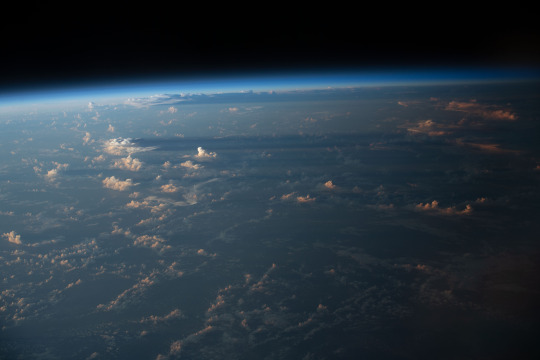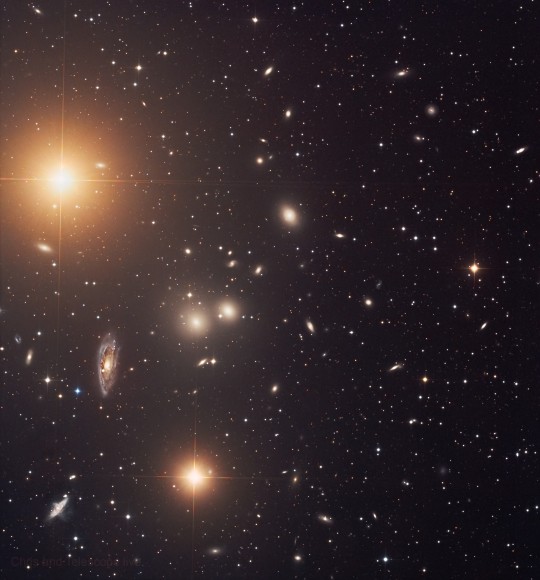Don't wanna be here? Send us removal request.
Text




fireweed meadow
Lake Twenty Two, Washington
191 notes
·
View notes
Text

The Hidden Galaxy, C5 // Ani Shastry
If this galaxy was not heavily obscured by dust in our own Galaxy, it would be visible to the naked eye on Earth! It has a diameter of about 75,000 light years, roughly three-quarters the size of the Milky Way. This equates to a size of about half a full moon on the sky. The best time to try and spot it is during late autumn and early winter in the northern hemisphere, so get out there and try to find it!
60 notes
·
View notes
Text

Cloud shadows stretch across the Earth during an orbital sunset as the International Space Station soared 258 miles above the Atlantic coast of Suriname in South America.
70 notes
·
View notes
Text

The Wishing Well Cluster, C91 // Alex Nicholas
Zooming out, we see that the Wishing Well Cluster (NGC 3532) is a truly beautiful cluster of about 150 stars. There are several red giant stars in the cluster, giving observers beautiful contrasting colors. The bright yellow star seen to the top left of the cluster is the star x Carinae, but it lies between the Sun and NGC 3532 and is not a member.
The Wishing Well Cluster was also the first target ever observed by the Hubble Space Telescope on May 20, 1990.
27 notes
·
View notes
Text

The Jewel Box, C94 // Douglas Fontana
The Jewel Box is an open cluster of just over 100 stars located about 7,000 light years away in the constellation of Crux, the Southern Cross. Although it was discovered by Nicolas-Louis de Lacaille (1713-1762) in 1752, it was named the Jewel Box by John Herschel (1792-1871) when he described it as "a superb piece of fancy jewellery." It is best seen during the autumn months in the southern hemisphere.
21 notes
·
View notes
Text

The Jewel Box, C94 // Szoomer
The Jewel Box Cluster (NGC 4755) is one of the youngest open clusters known, aged to only 16 million years old! Just like old school friends that drift apart after graduation, the stars in an open cluster only remain together for a limited time. They gradually disperse into space, pulled away by the gravitational tugs of other passing clusters and clouds of gas.
46 notes
·
View notes
Text

The Great Peacock Cluster, C93 // Massimo Di Fusco & Aygen
A glimmering globular cluster of over 100,000 stars, the Great Peacock Cluster (NGC 6752) is located about 13,000 light years from Earth in the constellation of Pavo, the Peacock. It was first identified by James Dunlop (1793-1848) in 1826, and is one of the closer globular clusters to the Earth. It is estimated that the cluster is about 11.8 billion years old.
16 notes
·
View notes
Photo

“Also known as NGC 4258, M106 is about 80,000 light-years across and 23.5 million light-years away, the largest member of the Canes II galaxy group.”��
Read more at APOD/NASA; Credit: Phil Keyser
384 notes
·
View notes
Text

The Hydra Cluster, Abell 1060 // Chris DeCosta
161 notes
·
View notes
Photo



Dreamscapes
1, 2, 3 by Uroš Novina on Flickr
2K notes
·
View notes
Text

The Omicron Velorum Cluster, C85 // Malcolm Park
Located about 574 light years away in the constellation of Vela, the Sails, is the Omicron Velorum Cluster (IC 2391). The Persian astronomer 'Abd al-Raḥmān al-Ṣūfī (903-986) described it as a "nebulous star" in about 964, although French astronomer Nicolas-Louis de Lacaille (1713-1762) is generally credited with its discovery in 1752.
The brightest star, and the namesake of the cluster, is o Velorum, a blue giant star about 5.5 times the mass and 4 times the radius of the Sun.
24 notes
·
View notes
Text

Messier 101 - Pinwheel Galaxy
space.by.jase on Instagram
289 notes
·
View notes
Text

The Shoe-Buckle Cluster (M35, center) and NGC 2158 (bottom) // Filip_Dziegielewski
41 notes
·
View notes



